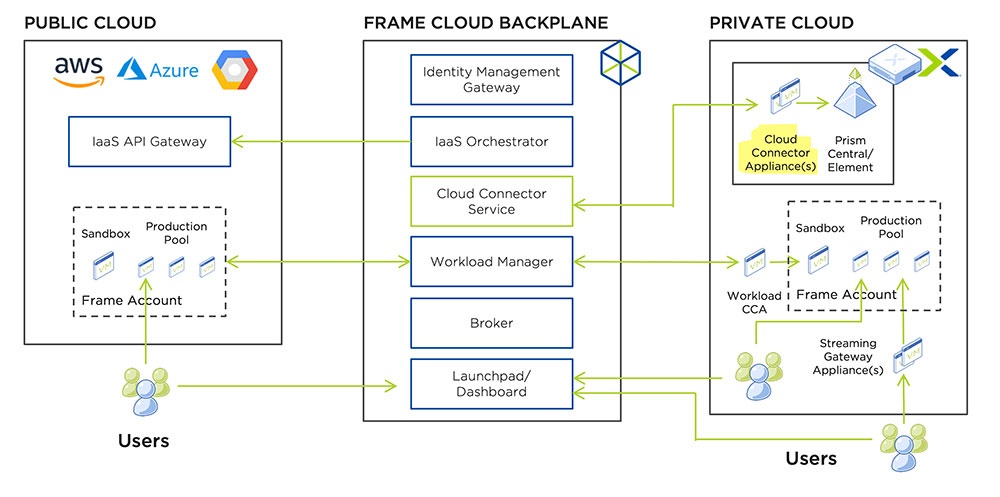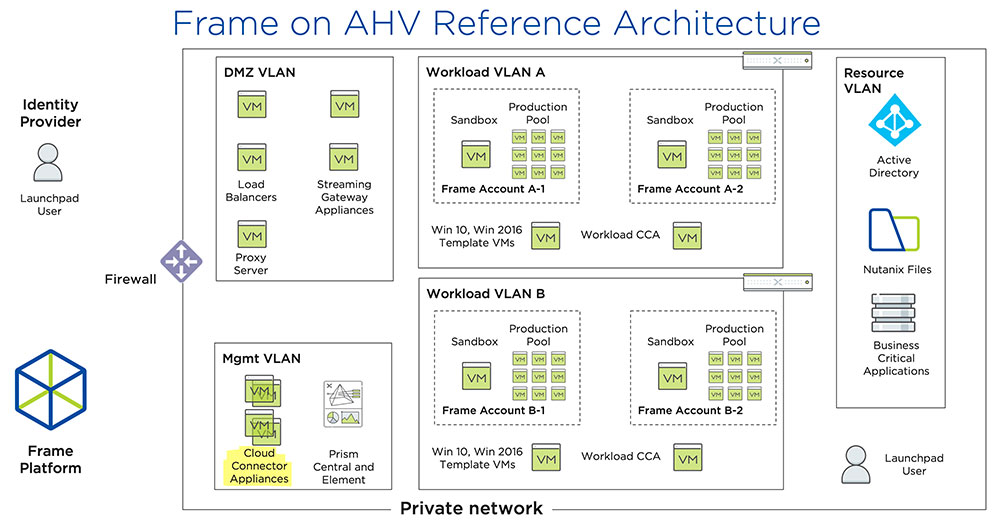In May of 2018, we announced Frame on AHV for deploying, running, and managing virtual desktop and application workload on Nutanix AHV - all still orchestrated from the Frame cloud backplane.
One of the core values of Frame is the ability to support workloads in multiple clouds, including public clouds with AWS, Azure, and Google Cloud, and on-premises powered by Nutanix AHV. It wasn’t a surprise that our customers started adopting Frame with AHV in volumes in a very short span of time. But we were impressed to see how many customers have also embraced a hybrid cloud model, with some workloads on-prem and some in the public cloud.
As our customer base continues to scale up, we’ve been working hard to respond to customer requests for more features and capabilities while keeping the service easy to use. Earlier this month, we took a big leap forward with the release of the Frame Cloud Connector Appliance (CCA) version 3.0. A CCA is an API proxy that establishes an outbound network communication channel between the Frame control plane and the Prism Central and Prism Element of your Nutanix AHV cluster. It’s essentially the interface between your private cloud and the Frame service.

The new CCA 3.0 introduces several new capabilities and improvements over its predecessor:
- High Availability - Frame administrators can now set up more than one CCA for a single Cloud Account and thereby prevent any downtime in cases where a single CCA may not be available. No additional load balancers are needed to create a high availability configuration with CCA 3.0.
- NVIDIA GRID vGPU backed Instances - An updated self-service procedure is now available to create and configure NVIDIA GRID vGPU workload machines while setting up your Cloud Account for your Nutanix AHV cluster.
- Use of Proxy Server - Admins can now set up the CCA to use a HTTPS proxy server. This allows secure outbound and inbound traffic from the CCA to the Frame service.
CCA 3.0 also has several other performance and usability improvements that provide an even better experience using Xi Frame on Nutanix AHV clusters.

Other recent updates to the Xi Frame service allow customers to self-service and maintain their configuration for Xi Frame on AHV. Administrators can now update the Template Image and also have multiple Template Images for the same OS family. Through the Frame console, administrators can modify the vLAN configuration for their desktops and also add or update instance types as their needs change over time.

These enhancements make Frame on Nutanix AHV a favorite solution for large enterprise customers. We appreciate their partnership and collaboration and look forward to building the next generation of capabilities for our differentiated DaaS solution on Nutanix AHV.
To learn more, check out the product documentation here. To try out these incredible Frame capabilities, sign-up for a 30-day trial at my.nutanix.com.
Author
More content created by
Ruben Spruijt© 2024 Dizzion, Inc. All rights reserved. Frame, the Frame logo and all Dizzio product, feature and service names mentioned herein are registered trademarks of Dizzion, Inc. in the United States and other countries. All other brand names mentioned herein are for identification purposes only and may be the trademarks of their respective holder(s). This post may contain links to external websites that are not part of Dizzion. Dizzion does not control these sites and disclaims all responsibility for the content or accuracy of any external site. Our decision to link to an external site should not be considered an endorsement of any content on such a site. Certain information contained in this post may relate to or be based on studies, publications, surveys and other data obtained from third-party sources and our own internal estimates and research. While we believe these third-party studies, publications, surveys and other data are reliable as of the date of this post, they have not independently verified, and we make no representation as to the adequacy, fairness, accuracy, or completeness of any information obtained from third-party sources.